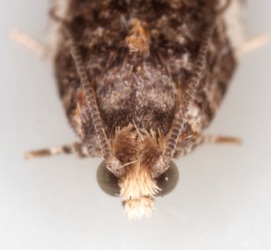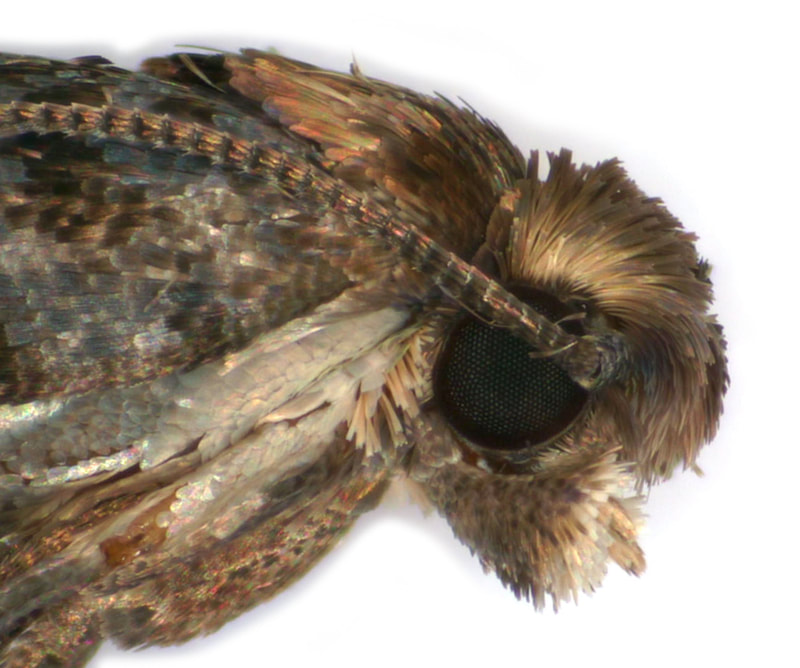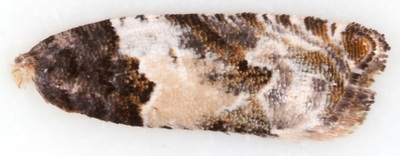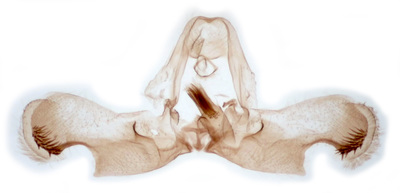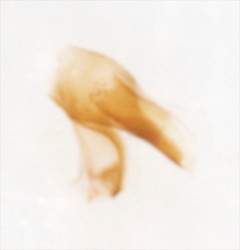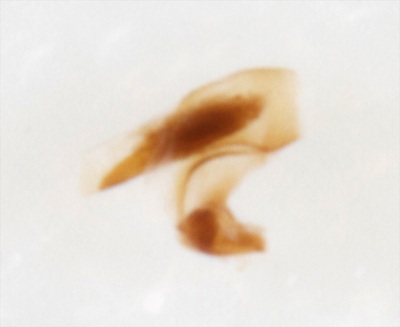49.279 Gypsonoma dealbana (Common Cloaked Tortrix)
ws: 11-14mm; Jun-Aug; various trees and shrubs including hazel (Corylus avellana), hawthorn (Crataegus spp), poplars (Populus spp), sallow (Salix spp); common throughout GB except N.Scotland.
ID: Similar to G.sociana, both species having a whitish frons. In G.sociana the frons is clear white, in G.dealbana it is creamy white. G.sociana always has a white ground colour, in G.dealbana this is often suffused greyish. According to MBGBI 5.2 the forewing apex is predominantly ferruginous in G.dealbana, dark fuscous in G.sociana - but this does not appear to provide a reliable means of distinguishing these species.
Male genitalia: ventral border of valva shallowly emariginate towards apex in G.sociana; deeply emarginate in G.dealbana
Female genitalia: Illustrated and described by Pierce and Metcalf, illustrated but not described in MBGBI5.2, shown at Moth Dissection.
Distinguishing features can be summarised thus: G.sociana: posterolateral angles of ostial plate ~90°; colliculum ~2x as long as wide, occupying ~⅓ the length of the ductus bursae and not continuous with the ostial plate. G.dealbana: ostial plate not so angular; colliculum ~4x as long as wide and occupying ~½ the length of the ductus bursae.
The illustrations in MBGBI5.2 do not show any very convincing difference between G.sociana and G.dealbana.
The crucial difference described and illustrated by P&M is that the ostial plate is angular in G.sociana and rounded in G.dealbana; they also illustrate the ostial plate as occupying ~80% of the diameter of S8 in G.sociana so that the plate is 2-3x wider than it is long, ~50% in G.dealbana and <2x wider than long. A difference in the ostial plate is also seen when comparing images at Moth Dissection: the ostial plate of G.sociana has a transverse posterior margin with angular posterolateral corners, while in G.dealbana the posterior margin slopes anteriorly from a midline prominence. (However, it should be noted that the ostial plate in G.dealbana is more naturally placed in the dorso-ventral plane of the abdomen so that the dorsal edge becomes the posterior margin in a set specimen, and the degree to which this transition can be achieved will vary with the degree of compression). The colliculum is not mentioned by P&M but in the images at Moth Dissection the differences are clear.
Male genitalia: ventral border of valva shallowly emariginate towards apex in G.sociana; deeply emarginate in G.dealbana
Female genitalia: Illustrated and described by Pierce and Metcalf, illustrated but not described in MBGBI5.2, shown at Moth Dissection.
Distinguishing features can be summarised thus: G.sociana: posterolateral angles of ostial plate ~90°; colliculum ~2x as long as wide, occupying ~⅓ the length of the ductus bursae and not continuous with the ostial plate. G.dealbana: ostial plate not so angular; colliculum ~4x as long as wide and occupying ~½ the length of the ductus bursae.
The illustrations in MBGBI5.2 do not show any very convincing difference between G.sociana and G.dealbana.
The crucial difference described and illustrated by P&M is that the ostial plate is angular in G.sociana and rounded in G.dealbana; they also illustrate the ostial plate as occupying ~80% of the diameter of S8 in G.sociana so that the plate is 2-3x wider than it is long, ~50% in G.dealbana and <2x wider than long. A difference in the ostial plate is also seen when comparing images at Moth Dissection: the ostial plate of G.sociana has a transverse posterior margin with angular posterolateral corners, while in G.dealbana the posterior margin slopes anteriorly from a midline prominence. (However, it should be noted that the ostial plate in G.dealbana is more naturally placed in the dorso-ventral plane of the abdomen so that the dorsal edge becomes the posterior margin in a set specimen, and the degree to which this transition can be achieved will vary with the degree of compression). The colliculum is not mentioned by P&M but in the images at Moth Dissection the differences are clear.
|
§1 New Forest, Hampshire; 27/06/2008; fw 6.5mm
§2 New Forest, Hampshire; 29/06/2009; female; fw 6.2mm §3 Westcliff-on-sea, Essex; 09/07/2010; male §4 Strumpshaw Fen, Norfolk; 27/07/2012; male §6 Bookham Common, Surrey; 16/07/2013; male; fw 6.3mm §7 Bookham Common, Surrey; 16/07/2013; female §8 Bookham Common, Surrey; 16/07/2013; male §9 Arne, Dorset; 02/07/2016; male; fw 6.1mm; to light All images © Chris Lewis |
§10 Removed, misidentification
§11 Orlestone Forest, Kent; 11/07/2018 §12 Dungeness, Kent; 12/07/2018; female; fw 5.9mm §13 Pound Wood, Essex; 11/07/2019; male; fw 5.5mm §14 Pound Wood, Essex; 11/07/2019; female; fw 5.7mm §15 Pound Wood, Essex; 11/07/2019; female; fw 5.5mm |
Page published 14/01/2013 (§1-8) | §9 added 29/09/2016 | §10 added 22/10/2017 | §11 added 18/05/2019 | §12 added 24/05/2019 |
§13-15 aded 25/02/2020 | §10 removed and female genitalia text added 09/07/2024
§13-15 aded 25/02/2020 | §10 removed and female genitalia text added 09/07/2024











